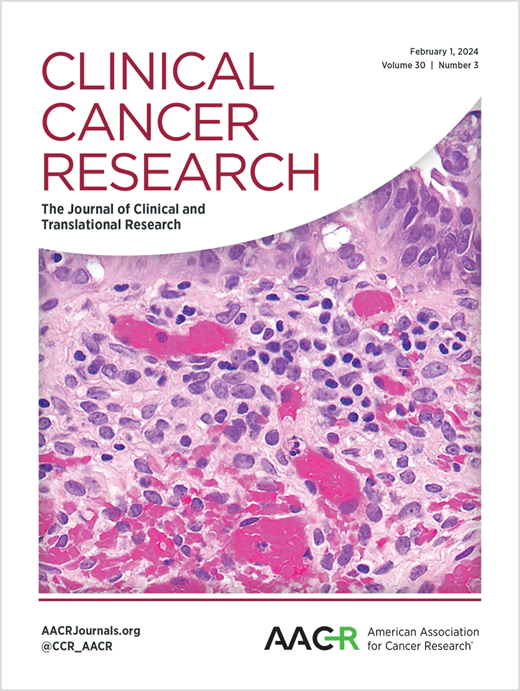Leveraging Longitudinal Patient-Reported Outcomes Trajectories to Predict Survival in Non-Small-Cell Lung Cancer
IF 10
1区 医学
Q1 ONCOLOGY
引用次数: 0
Abstract
Purpose: Despite their potential, patient-reported outcomes (PRO) are often underutilized in clinical decision-making, especially when improvements in PRO do not align with clinical outcomes. This misalignment may result from insufficient analytical methods that overlook the temporal dynamics and substantial variability of PRO data. To address these gaps, we developed a novel approach to investigate the prognostic value of longitudinal PRO dynamics in non-small-cell lung cancer (NSCLC) using Lung Cancer Symptom Scale (LCSS) data. Methods: Longitudinal patient-reported LCSS data from 481 NSCLC participants in the placebo arm of a Phase III trial were analyzed. A population modeling approach was applied to describe PRO progression trajectories while accounting for substantial variability in the data. Associations between PRO model parameters and survival outcomes were assessed using Cox proportional hazards models. Model-informed PRO parameters were used to predict survival via machine learning. Results: A PRO progression model described LCSS dynamics and predicted a median time to symptom progression of 229 days (95% confidence interval [CI]: 15-583). Faster PRO progression rates were significantly associated with poorer survival (Hazard ratio [HR] 1.13, 95% CI: 1.076-1.18), while greater improved PRO effects by placebo/prior treatment correlated with improved survival (HR 0.93, 95% CI: 0.883-0.99). A machine learning model using PRO parameters achieved an AUC-ROC of 0.78, demonstrating their potential to predict overall survival. Conclusions: This study demonstrates that longitudinal PRO data can provide prognostic insights into survival in NSCLC. The findings support the use of PRO dynamics to improve clinical decision-making and optimize patient-centered treatment strategies.利用纵向患者报告的结局轨迹来预测非小细胞肺癌的生存
目的:尽管具有潜力,但患者报告预后(PRO)在临床决策中往往未得到充分利用,特别是当PRO的改善与临床结果不一致时。这种偏差可能是由于分析方法不充分,忽视了PRO数据的时间动态和实质性变异性。为了解决这些空白,我们开发了一种新的方法,利用肺癌症状量表(LCSS)数据来研究纵向PRO动态在非小细胞肺癌(NSCLC)中的预后价值。方法:对一项III期试验中481名非小细胞肺癌安慰剂组患者报告的纵向LCSS数据进行分析。采用人口建模方法来描述PRO的进展轨迹,同时考虑到数据中的实质性变化。使用Cox比例风险模型评估PRO模型参数与生存结果之间的关系。模型通知PRO参数用于通过机器学习预测生存率。结果:PRO进展模型描述了LCSS动态,并预测到症状进展的中位时间为229天(95%置信区间[CI]: 15-583)。更快的PRO进展率与较差的生存率显著相关(风险比[HR] 1.13, 95% CI: 1.076-1.18),而安慰剂/先前治疗对PRO效果的改善与生存率的改善相关(风险比0.93,95% CI: 0.883-0.99)。使用PRO参数的机器学习模型实现了0.78的AUC-ROC,证明了它们预测总体生存的潜力。结论:本研究表明,纵向PRO数据可以为非小细胞肺癌的生存提供预后见解。研究结果支持使用PRO动力学来改善临床决策和优化以患者为中心的治疗策略。
本文章由计算机程序翻译,如有差异,请以英文原文为准。
求助全文
约1分钟内获得全文
求助全文
来源期刊

Clinical Cancer Research
医学-肿瘤学
CiteScore
20.10
自引率
1.70%
发文量
1207
审稿时长
2.1 months
期刊介绍:
Clinical Cancer Research is a journal focusing on groundbreaking research in cancer, specifically in the areas where the laboratory and the clinic intersect. Our primary interest lies in clinical trials that investigate novel treatments, accompanied by research on pharmacology, molecular alterations, and biomarkers that can predict response or resistance to these treatments. Furthermore, we prioritize laboratory and animal studies that explore new drugs and targeted agents with the potential to advance to clinical trials. We also encourage research on targetable mechanisms of cancer development, progression, and metastasis.
 求助内容:
求助内容: 应助结果提醒方式:
应助结果提醒方式:


